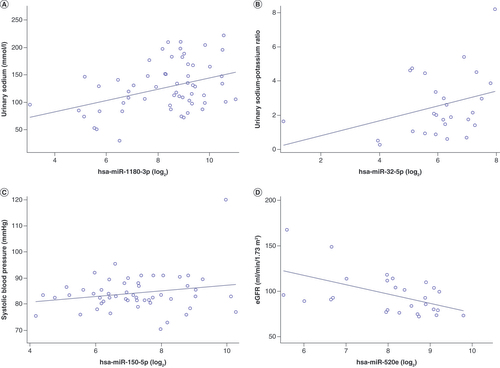Figures & data
Table 1. Demographic characteristics of the 88 children participating in this PROGRESS subcohort at 4–6 years of age.
Table 2. Association between exo-miRs and urinary sodium concentration.Table Footnoteâ€
Table 3. Association between exo-miRs and urinary sodium-to-potassium ratio.Table Footnoteâ€
Table 4. Association between exo-miRs and eGFR assessed at 8–10 years old.Table Footnoteâ€
Representative plots of the top (based on lowest p-value) associations between exo-miRs and cardiorenal outcomes, including (A) urinary sodium and miR-1180 (n = 59), (B) urinary sodium-to-potassium ratio and miR-32-5p (n = 27), (C) systolic blood pressure and miR-150-5p (n = 53) and (D) eGFR and miR-520e (n = 27). The plots are unadjusted regression lines.
eGFR: Estimated glomerular filtration rate; exo-miRs: Exosomal miRNAs.

Data sharing statement
Access to the data is limited because of a data sharing agreement approved by the institutional review board at Mount Sinai. However, the data from this study are accessible to qualified researchers upon reasonable request pursuant to the following restrictions to ensure the privacy of human subjects. Researchers interested in accessing PROGRESS data must send their resume or curriculum vitae and Collaborative Institutional Training Initiative training certificate to the institutional review board chair, I Wilets ([email protected]). They must also send a data analysis plan to the principal investigators for PROGRESS, RO Wright ([email protected]), M Tellez-Rojo ([email protected]) and AA Baccarelli ([email protected]). When this process is completed and the request is approved, the PROGRESS data analyst, N McRae ([email protected]), will send a de-identified dataset via the secure data sharing platform box.
